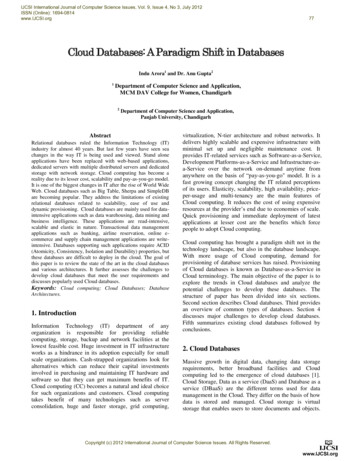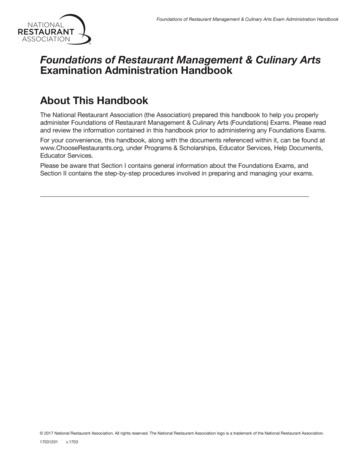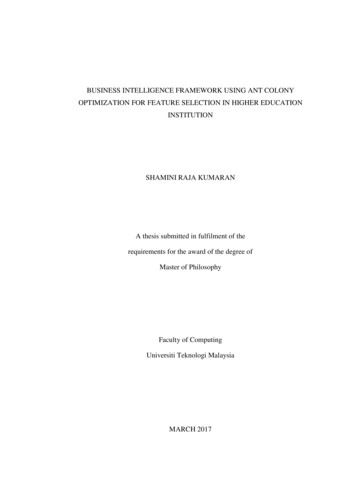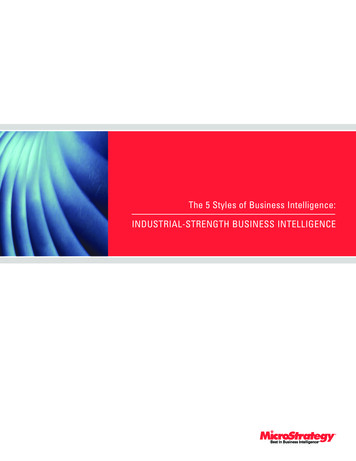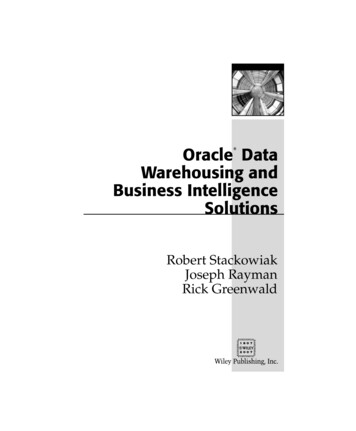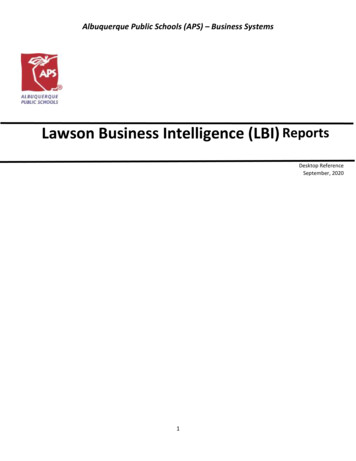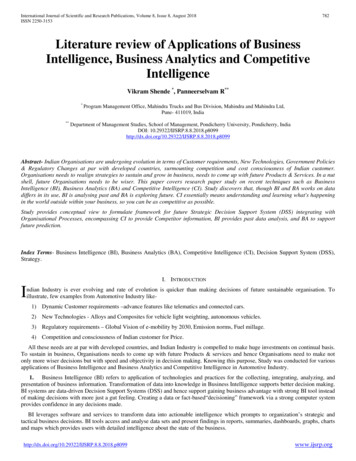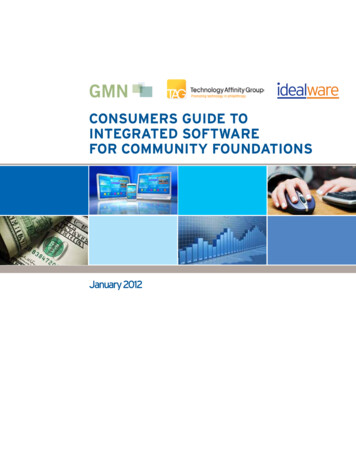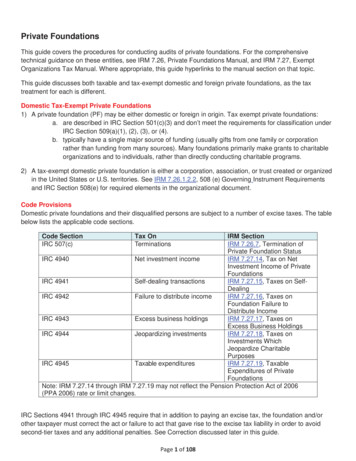
Transcription
10/6/2013Foundations ofBusiness Intelligence:Databases andInformationManagement Problem: HP’s numerous systems unable to deliver theinformation needed for a complete picture of businessoperations, lack of data consistency Solutions: Build a data warehouse with a single globalenterprise-wide database; replacing 17 databasetechnologies and 14,000 databases in use Created consistent data models for all enterprise dataand proprietary platform Demonstrates importance of database management increating timely, accurate data and reports Illustrates need to standardize how data from disparatesources are stored, organized, and managed1
10/6/2013 File organization concepts Computer system organizes data in a hierarchy Field: Group of characters as word(s) or numberRecord: Group of related fieldsFile: Group of records of same typeDatabase: Group of related files Record: Describes an entity Entity: Person, place, thing on which we storeinformation Attribute: Each characteristic, or quality, describing entity E.g., Attributes Date or Grade belong to entity COURSEThe Data HierarchyA computer systemorganizes data in ahierarchy that starts with thebit, which represents eithera 0 or a 1. Bits can begrouped to form a byte torepresent one character,number, or symbol. Bytescan be grouped to form afield, and related fields canbe grouped to form a record.Related records can becollected to form a file, andrelated files can beorganized into a database.Figure 6-12
10/6/2013 Problems with the traditional file environment (filesmaintained separately by different departments) Data redundancy and inconsistency Data redundancy: Presence of duplicate data in multiple files Data inconsistency: Same attribute has different values Program-data dependence: When changes in program requires changes to data accessed byprogram Lack of flexibility Poor security Lack of data sharing and availabilityTraditional File ProcessingThe use of a traditional approach to file processing encourages each functional area in a corporation todevelop specialized applications and files. Each application requires a unique data file that is likely to be asubset of the master file. These subsets of the master file lead to data redundancy and inconsistency,processing inflexibility, and wasted storage resources.Figure 6-23
10/6/2013 Database Collection of data organized to serve many applications bycentralizing data and controlling redundant data Database management system Interfaces between application programs and physical data files Separates logical and physical views of data Solves problems of traditional file environment Controls redundancy Eliminates inconsistency Uncouples programs and data Enables organization to central manage data and data securityHuman Resources Database with Multiple ViewsA single human resources database provides many different views of data, depending on the informationrequirements of the user. Illustrated here are two possible views, one of interest to a benefits specialist andone of interest to a member of the company’s payroll department.Figure 6-34
10/6/2013The Database Approach to Data Management Relational DBMS Represent data as two-dimensional tables called relations or files Each table contains data on entity and attributes Table: grid of columns and rows Rows (tuples): Records for different entities Fields (columns): Represents attribute for entity Key field: Field used to uniquely identify each record Primary key: Field in table used for key fields Foreign key: Primary key used in second table as look-up field toidentify records from original tableThe Database Approach to Data ManagementRelational Database TablesA relational database organizes data in the form of two-dimensional tables. Illustrated here are tables forthe entities SUPPLIER and PART showing how they represent each entity and its attributes.Supplier Number is a primary key for the SUPPLIER table and a foreign key for the PART table.Figure 6-4A5
10/6/2013The Database Approach to Data ManagementRelational Database Tables (cont.)Figure 6-4BThe Database Approach to Data Management Operations of a Relational DBMS Three basic operations used to develop useful sets of data SELECT: Creates subset of data of all records thatmeet stated criteria JOIN: Combines relational tables to provide user withmore information than available in individual tables PROJECT: Creates subset of columns in table,creating tables with only the information specified6
10/6/2013The Database Approach to Data ManagementThe Three Basic Operations of a Relational DBMSThe select, project, and join operations enable data from two different tables to be combined and onlyselected attributes to be displayed.Figure 6-5The Database Approach to Data Management Object-Oriented DBMS (OODBMS) Stores data and procedures as objects Capable of managing graphics, multimedia, Javaapplets Relatively slow compared with relational DBMS forprocessing large numbers of transactions Hybrid object-relational DBMS: Provide capabilitiesof both OODBMS and relational DBMS7
10/6/2013The Database Approach to Data Management Capabilities of Database Management Systems Data definition capability: Specifies structure of databasecontent, used to create tables and define characteristics of fields Data dictionary: Automated or manual file storing definitions ofdata elements and their characteristics Data manipulation language: Used to add, change, delete,retrieve data from database Structured Query Language (SQL) Microsoft Access user tools for generation SQL Many DBMS have report generation capabilities for creatingpolished reports (Crystal Reports)The Database Approach to Data ManagementExample of an SQL QueryIllustrated here are the SQL statements for a query to select suppliers for parts 137 or 150. They produce alist with the same results as Figure 6-5.Figure 6-78
10/6/2013The Database Approach to Data ManagementAn Access QueryIllustrated here is how the query in Figure 6-7 would be constructed using query-building tools in theAccess Query Design View. It shows the tables, fields, and selection criteria used for the query.Figure 6-8The Database Approach to Data Management Designing Databases Conceptual (logical) design: abstract model from businessperspective Physical design: How database is arranged on direct-accessstorage devices Design process identifies Relationships among data elements, redundant databaseelements Most efficient way to group data elements to meet businessrequirements, needs of application programs Normalization Streamlining complex groupings of data to minimize redundantdata elements and awkward many-to-many relationships9
10/6/2013The Database Approach to Data ManagementAn Unnormalized Relation for OrderAn unnormalized relation contains repeating groups. For example, there can be many parts and suppliersfor each order. There is only a one-to-one correspondence between Order Number and Order Date.Figure 6-9The Database Approach to Data ManagementNormalized Tables Created from OrderAfter normalization, the original relation ORDER has been broken down into four smaller relations. Therelation ORDER is left with only two attributes and the relation LINE ITEM has a combined, orconcatenated, key consisting of Order Number and Part Number.Figure 6-1010
10/6/2013The Database Approach to Data Management Entity-relationship diagram Used by database designers to document the data model Illustrates relationships between entities Distributing databases: Storing database in more thanone place Partitioned: Separate locations store different parts of database Replicated: Central database duplicated in entirety at differentlocationsThe Database Approach to Data ManagementAn Entity-Relationship DiagramThis diagram shows the relationships between the entities ORDER, LINE ITEM, PART, and SUPPLIER thatmight be used to model the database in Figure 6-10.Figure 6-1111
10/6/2013The Database Approach to Data Management Distributing databases Two main methods of distributing a database Partitioned: Separate locations store different parts ofdatabase Replicated: Central database duplicated in entirety atdifferent locations Advantages Reduced vulnerability Increased responsiveness Drawbacks Departures from using standard definitions Security problemsUsing Databases to Improve Business Performance and Decision Making Very large databases and systems require specialcapabilities, tools To analyze large quantities of data To access data from multiple systems Three key techniques Data warehousing Data mining Tools for accessing internal databases through the Web12
10/6/2013Using Databases to Improve Business Performance and Decision Making Data warehouse: Stores current and historical data from many core operationaltransaction systems Consolidates and standardizes information for use acrossenterprise, but data cannot be altered Data warehouse system will provide query, analysis, and reportingtools Data marts: Subset of data warehouse Summarized or highly focused portion of firm’s data for use byspecific population of users Typically focuses on single subject or line of businessUsing Databases to Improve Business Performance and Decision MakingComponents of a Data WarehouseThe data warehouse extracts current and historical data from multiple operational systems inside theorganization. These data are combined with data from external sources and reorganized into a centraldatabase designed for management reporting and analysis. The information directory provides userswith information about the data available in the warehouse.Figure 6-1313
10/6/2013Using Databases to Improve Business Performance and Decision MakingThe IRS Uncovers Tax Fraud with a Data Warehouse Read the Interactive Session: Organizations, and thendiscuss the following questions: Why was it so difficult for the IRS to analyze the taxpayer datait had collected? What kind of challenges did the IRS encounter whenimplementing its CDW? What management, organization, andtechnology issues had to be addressed? How did the CDW improve decision making and operations atthe IRS? Are there benefits to taxpayers? Do you think data warehouses could be useful in other areasof the federal sector? Which ones? Why or why not?Using Databases to Improve Business Performance and Decision Making Business Intelligence: Tools for consolidating, analyzing, and providing accessto vast amounts of data to help users make betterbusiness decisions E.g., Harrah’s Entertainment analyzes customers todevelop gambling profiles and identify most profitablecustomers Principle tools include: Software for database query and reporting Online analytical processing (OLAP) Data mining14
10/6/2013Using Databases to Improve Business Performance and Decision MakingBusiness IntelligenceFigure 6-14A series of analytical toolsworks with data stored indatabases to find patternsand insights for helpingmanagers and employeesmake better decisions toimprove organizationalperformance.Using Databases to Improve Business Performance and Decision Making Online analytical processing (OLAP) Supports multidimensional data analysis Viewing data using multiple dimensions Each aspect of information (product, pricing, cost,region, time period) is different dimension E.g., how many washers sold in East in Junecompared with other regions? OLAP enables rapid, online answers to ad hoc queries15
10/6/2013Using Databases to Improve Business Performance and Decision MakingMultidimensional Data ModelFigure 6-15The view that is showing isproduct versus region. Ifyou rotate the cube 90degrees, the face that willshow is product versusactual and projected sales. Ifyou rotate the cube 90degrees again, you will seeregion versus actual andprojected sales. Other viewsare possible.Using Databases to Improve Business Performance and Decision Making Data mining: More discovery driven than OLAP Finds hidden patterns, relationships in large databases and infersrules to predict future behavior E.g., Finding patterns in customer data for one-to-one marketingcampaigns or to identify profitable customers. Key areas where businesses are leveraging data mininginclude: Customer segmentation Marketing and promotion targeting Market basket analysis Collaborative filtering Customer churn Fraud detection Financial modeling Hiring and promotion16
10/6/2013 Data mining:. Types of information obtainable from data mining Associations- An association algorithm creates rules that describe how oftenevents have occurred together. Example: When a customer buys a hammer, then 90% of the time they will buynails.Sequences- Events linked over time Classification - Recognizes patterns that describe group to which item belongs Example: A bank wants to classify its Home Loan Customers into groupsaccording to their response to bank advertisements. The bank might use theclassifications “Responds Rarely, Responds Sometimes, Responds Frequently”. Clustering - Similar to classification, but when no groups have been defined; findsgroupings within data Example: Insurance company could use clustering to group clients by their age,location and types of insurance purchased. The categories are unspecified and this is referred to as ‘unsupervised learning’Forecasting - Uses series of existing values to forecast what other values will be We’ll do this in class with regression analysis Regression deals with the prediction of a value, rather than a class Example: Find out if there is a relationship between smoking patients andcancer related illness.Data Mining A data mining and business analyticsteam should possesses three criticalskills:– Information technology– Statistics– Business knowledge11-3417
10/6/2013Using Databases to Improve Business Performance and Decision Making Predictive analysis Uses data mining techniques, historical data, andassumptions about future conditions to predictoutcomes of events E.g., Probability a customer will respond to an offer orpurchase a specific product Text mining Extracts key elements from large unstructured data sets(e.g., stored e-mails)Artificial Intelligence Data Mining has its roots in a branch of computerscience known as artificial intelligence (AI) The goal of AI is create computer programs that areable to mimic or improve upon functions of thehuman brain11-3618
10/6/2013Artificial Intelligence Neural network: An AI system that examines dataand hunts down and exposes patterns, in order tobuild models to exploit findings Expert systems: AI systems that leverage rules orexamples to perform a task in a way that mimicsapplied human expertise Genetic algorithms: Model building techniqueswhere computers examine many potentialsolutions to a problem, iteratively modifyingvarious mathematical models, and comparing themutated models to search for a best alternative11-37Using Databases to Improve Business Performance and Decision Making Web mining Discovery and analysis of useful patterns and informationfrom WWW E.g., to understand customer behavior, evaluateeffectiveness of Web site, etc.Techniques Web content mining Knowledge extracted from content of Web pages Web structure mining Web usage mining E.g., links to and from Web pageUser interaction data recorded by Web server19
10/6/2013Using Databases to Improve Business Performance and Decision Making Databases and the Web Many companies use Web to make some internaldatabases available to customers or partners Typical configuration includes: Web server Application server/middleware/CGI scripts Database server (hosting DBM) Advantages of using Web for database access: Ease of use of browser software Web interface requires few or no changes to database Inexpensive to add Web interface to systemManaging Data Resources Establishing an information policy Firm’s rules, procedures, roles for sharing, managing, standardizingdata E.g., What employees are responsible for updating sensitiveemployee information Data administration: Firm function responsible for specific policiesand procedures to manage data Data governance: Policies and processes for managing availability,usability, integrity, and security of enterprise data, especially as itrelates to government regulations Database administration : Defining, organizing, implementing,maintaining database; performed by database design andmanagement group20
10/6/2013Managing Data Resources Ensuring data quality More than 25% of critical data in Fortune 1000company databases are inaccurate or incomplete Most data quality problems stem from faulty input Before new database in place, need to: Identify and correct faulty data Establish better routines for editing data oncedatabase in operationManaging Data Resources Data quality audit: Structured survey of the accuracy and level ofcompleteness of the data in an information system Survey samples from data files, or Survey end users for perceptions of quality Data cleansing Software to detect and correct data that are incorrect,incomplete, improperly formatted, or redundant Enforces consistency among different sets of data fromseparate information systems21
10/6/2013Privacy Concerns Effective Data Mining requires large sources of data To achieve a wide spectrum of data, must link multiple data sources Linking sources leads can be problematic for privacy as follows: If thefollowing histories of a customer were linked:––––Shopping HistoryCredit HistoryBank HistoryEmployment History The users’ life story can be painted from the collected data Hiring, loan, other decision are made by data collected onindividuals.– What happens if the data is not correct? Data aggregators (data brokers) – it’s legal to buy and sellpersonal data.– Is this ethical?22
Business Intelligence Figure 6-14 A series of analytical tools works with data stored in databases to find patterns and insights for helping managers and employees make better decisions to improve organizational performance. Using Databases to Improve Business Performance and Decision Making Online analytical processing (OLAP)
